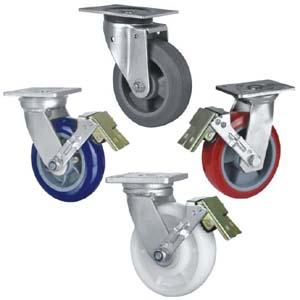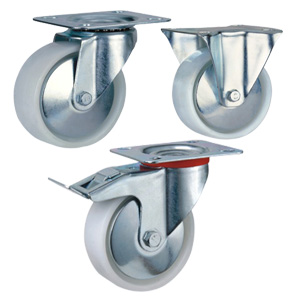- Best Price! Direct China Factory!
- Send Inquiry
WhatsApp/WeChat: 0086-137-36454395
Casters are included among the most important parts of trolleys and other mobile machinery and equipment. Among the most common casters are heavy duty casters, which are essentially heavy duty trolley wheels. Heavy-duty casters are used to facilitate the movement of different machinery. Heavy-duty casters are essentially used to move very heavy loads, around 20,000 lbs or more, from one place to another. These heavy loads can include furniture, tools, shopping carts, and even heavier items such as doors for airplanes, etc.
Advantages Of Heavy Duty Casters:
There are many advantages of using heavy-duty casters for a business, and most of these advantages stem from the fact that the wheels are designed to carry such large weights. Following are some of the advantages of heavy duty wheels for carts.
They’re Better For your Posture
Heavy duty caster wheels are designed to be ergonomic and friendly to the operator’s posture. They are designed in a way that when an operator pushes or operates the machinery with the heavy weighted objects on it, the machinery will move with ease, and the operator will not have to exert a large force or a giant push to make the trolley move.
In the case of regular casters, which are not designed to move heavy items, the operator has to exert a large force and often compromise their posture when moving these items. This is where heavy duty casters offer a massive advantage to people who use them.
They’ll Carry Anything
Heavy duty casters are intended to move around extremely weighty objects, many of which can weigh more than 20,000 lbs. So in an industry where you need to move around large parts and items, using these casters will save you so much time and effort! Naturally, even the unloading time is reduced since the work of multiple rounds is completed in a single round. A regular caster will break down after very few runs if you load it up with the same weight.
Everything They Carry Is Safe
One of the best features of heavy duty wheels for carts is that they have shock-absorbing abilities. Therefore, you can easily move your cart or machinery on rough terrain or on cracked flowing and you can rest assured that the caster will absorb the impact from the rough patch and will not allow any harm to come to the objects loaded on the trolley.
The shock-absorbing ability of heavy duty casters comes from the material used to craft them. Heavy-duty casters often have a stainless steel core with a rubber or nylon covering, which is thick and can easily allow the wheel to glide on all kinds of surfaces.
They’re Useful Everywhere
Heavy-duty casters are used in a large number of industries, from the aviation and automobile industries to being used to move furniture and carry heavy machinery. These casters are so widely used in all of these industries because they save a lot of time that would otherwise just be wasted in loading and unloading items from the trolley. When it comes to load bearing transportation or even moving heavy pieces of medical equipment such as MRIs or X-ray machines, heavy-duty casters provide the ideal support.
They Come In All Sizes And Materials
Heavy duty casters are also very versatile. There is no singular design that encompasses all heavy-duty casters. Instead, various designs with different degrees of functionality and different uses make up all heavy-duty casters. For example, rubber coated casters are suitable for wet and slippery surfaces to prevent the wheels from skidding. This versatility allows a heavy duty caster to be used in many different industries and benefit the workers while greatly improving productivity.
Reliable Till The End
Heavy duty casters are designed specially to withstand a lot of weight and be able to move smoothly from one place to another. The main reasons for caster failure include loading very weighty objects on the trolley and putting extra pressure on the wheels, along with rolling the wheels on a rough or cracked surface, which can hamper the integrity of the wheel and make it buckle under the pressure.
Heavy duty casters are specifically designed to endure both of these issues effectively. This is not to say that heavy duty casters do not fail, but their chances of failure are just much lower than those of most other caster wheels. With proper maintenance, they can last for a very long time.

Disadvantages Of Heavy Duty Casters:
There are many excellent associations with heavy-duty casters, but they make us wonder why every industry does not use these for their daily functions. Here is why:
Not For Speedy Work
Heavy duty casters are much slower than other regular casters. While this attribute is a benefit when heavyweights are involved, in industries where speed is synonymous with productivity, these heavy-duty casters can also be a massive hindrance.
Not For Everyone’s Pocket
Heavy duty casters are very carefully designed to complete the functions that they are able to perform, and naturally, this makes them more expensive than the average caster. If an industry does not need to use heavy-duty casters and they do not need to move around heavy loads of equipment, they can easily get regular casters for a much smaller price.
Customize Your Own Heavy Duty Casters
You can customize your heavy-duty casters to fit your job description even better. Some of the features you can make use of include the following:
Add Brakes
For some industries, adding locking and braking mechanisms to heavy-duty casters is essential. This is to keep the trolley in place when it is not intended to move. Without the brake, if the trolley begins to move unprompted, it could damage the objects it is carrying and cause other mishaps in the industry as well.
Make It Kingpinless
For all casters, if they have a kingpin included, that is where all the pressure on the wheel accumulates. If the pressure becomes more than what the wheel can handle, it often fails. Heavy duty casters are often kingpinless, so all the weight on the wheel is distributed throughout the wheel instead of concentrated on one spot.
Swivel Or Single Direction
Heavy duty casters can either swivel or move in a single direction. Casters that move in a single direction are often used on platforms and other machinery that does not need to change direction, and casters that swivel are much more versatile.


 English
English Spanish
Spanish German
German Russian
Russian Arabic
Arabic Portuguese
Portuguese Italian
Italian French
French Hebrew
Hebrew Turkish
Turkish